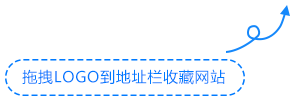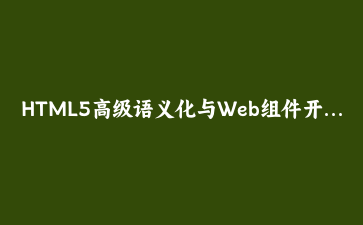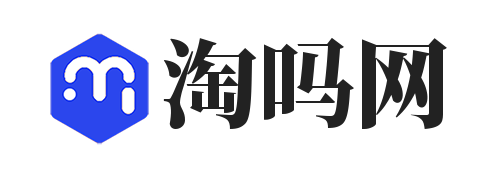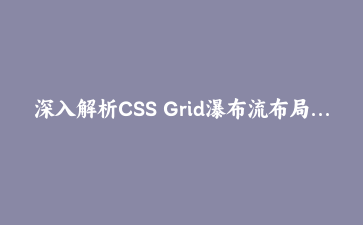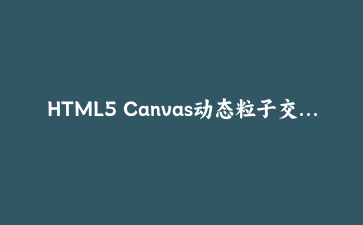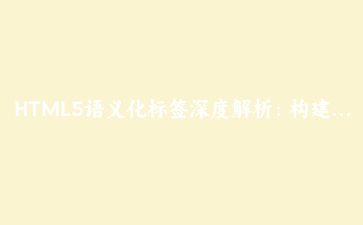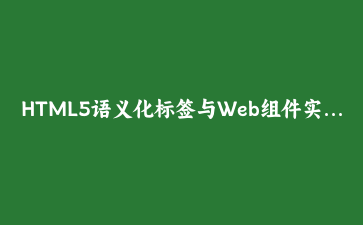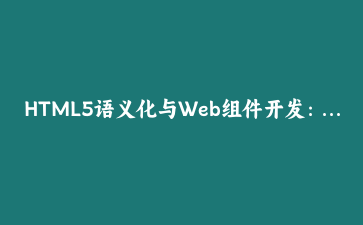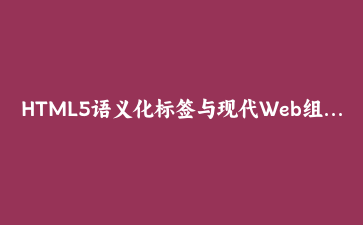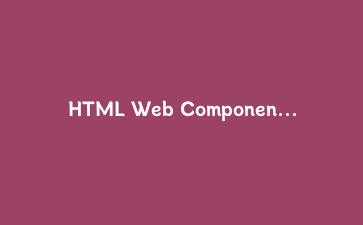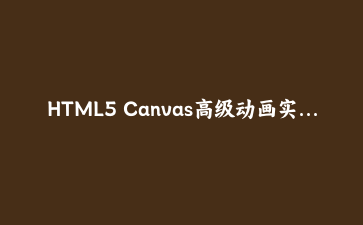一、HTML5语义化标签深度解析
理解语义化标签的设计哲学与实际应用场景
语义化标签的核心价值
语义化HTML5不仅提升代码可读性,更重要的是为辅助技术、搜索引擎和开发者提供清晰的结构信息。
主要语义化标签分类:
<main>- 定义文档主要内容区域,每个页面应只有一个
<article>- 表示独立的内容区块,如博客文章、新闻稿件
<section>- 对文档进行逻辑分区,通常包含标题
<aside>- 表示与主要内容间接相关的附加内容
<figure> 与 <figcaption>- 组合使用,为图片、图表等提供标题说明
语义化结构设计模式
<article class="blog-post">
<header>
<h1>文章标题</h1>
<time datetime="2024-01-20">2024年1月20日</time>
<address>作者:张三</address>
</header>
<section>
<h2>章节标题</h2>
<p>正文内容...</p>
<figure>
<img src="diagram.jpg" alt="技术架构图">
<figcaption>图1:系统架构示意图</figcaption>
</figure>
</section>
<footer>
<p>标签:<mark>HTML5</mark>, <mark>语义化</mark></p>
</footer>
</article>二、高级HTML5标签实战应用
1. 细节展示标签:<details> 与 <summary>
点击查看技术要点
实现原理:details元素创建可折叠的内容区块,summary提供标题。
优势:无需JavaScript即可实现交互效果,提升用户体验。
<details class="faq-item">
<summary>
<h4>什么是Web组件?</h4>
</summary>
<div class="faq-content">
<p>Web组件是一套不同的技术,允许您创建可重用的定制元素...</p>
</div>
</details>2. 进度与计量标签
85%
85%
65%
<!-- 计量器表示标量值 -->
<meter value="0.85" min="0" max="1">85%</meter>
<!-- 进度条表示任务进度 -->
<progress value="65" max="100">65%</progress>3. 数据列表与模板标签
<!-- datalist提供输入建议 -->
<label for="framework">选择前端框架:</label>
<input list="frameworks" id="framework" name="framework">
<datalist id="frameworks">
<option value="React">
<option value="Vue">
<option value="Angular">
<option value="Svelte">
</datalist>
<!-- template定义可复用的HTML模板 -->
<template id="user-card-template">
<div class="user-card">
<img class="avatar" src="" alt="">
<h3 class="username"></h3>
<p class="email"></p>
</div>
</template>三、原生Web组件开发实战
Custom Elements 自定义元素
创建可复用的自定义HTML元素,扩展浏览器原生能力。
// 定义用户卡片组件
class UserCard extends HTMLElement {
constructor() {
super();
this.attachShadow({ mode: 'open' });
}
static get observedAttributes() {
return ['username', 'avatar', 'email'];
}
connectedCallback() {
this.render();
}
attributeChangedCallback(name, oldValue, newValue) {
if (oldValue !== newValue) {
this.render();
}
}
render() {
const username = this.getAttribute('username') || '匿名用户';
const avatar = this.getAttribute('avatar') || 'default-avatar.jpg';
const email = this.getAttribute('email') || '';
this.shadowRoot.innerHTML = `
<div class="user-card">
<img src="${avatar}" alt="${username}" class="avatar">
<div class="user-info">
<h3>${username}</h3>
${email ? `<p>${email}</p>` : ''}
</div>
<slot name="actions"></slot>
</div>
<style>
.user-card {
display: flex;
align-items: center;
padding: 1rem;
border: 1px solid #e0e0e0;
border-radius: 8px;
margin: 0.5rem 0;
}
.avatar {
width: 50px;
height: 50px;
border-radius: 50%;
margin-right: 1rem;
}
.user-info h3 {
margin: 0 0 0.5rem 0;
color: #333;
}
.user-info p {
margin: 0;
color: #666;
}
</style>
`;
}
}
// 注册自定义元素
customElements.define('user-card', UserCard);Shadow DOM 封装技术
创建隔离的DOM树,实现样式和行为封装。
class ModalDialog extends HTMLElement {
constructor() {
super();
const shadow = this.attachShadow({ mode: 'open' });
const template = document.createElement('template');
template.innerHTML = `
<div class="modal-backdrop">
<div class="modal-content">
<header class="modal-header">
<h2><slot name="title">默认标题</slot></h2>
<button class="close-btn" aria-label="关闭">×</button>
</header>
<div class="modal-body">
<slot></slot>
</div>
<footer class="modal-footer">
<slot name="footer"></slot>
</footer>
</div>
</div>
<style>
.modal-backdrop {
position: fixed;
top: 0;
left: 0;
width: 100%;
height: 100%;
background: rgba(0,0,0,0.5);
display: flex;
justify-content: center;
align-items: center;
z-index: 1000;
}
.modal-content {
background: white;
border-radius: 8px;
min-width: 400px;
max-width: 90vw;
box-shadow: 0 4px 6px rgba(0,0,0,0.1);
}
.modal-header {
display: flex;
justify-content: between;
align-items: center;
padding: 1rem;
border-bottom: 1px solid #e0e0e0;
}
.close-btn {
background: none;
border: none;
font-size: 1.5rem;
cursor: pointer;
}
.modal-body {
padding: 1rem;
}
.modal-footer {
padding: 1rem;
border-top: 1px solid #e0e0e0;
text-align: right;
}
</style>
`;
shadow.appendChild(template.content.cloneNode(true));
// 添加事件监听
shadow.querySelector('.close-btn').addEventListener('click', () => {
this.close();
});
shadow.querySelector('.modal-backdrop').addEventListener('click', (e) => {
if (e.target === e.currentTarget) {
this.close();
}
});
}
close() {
this.remove();
}
}
customElements.define('modal-dialog', ModalDialog);四、完整实战案例:可复用通知系统
通知组件设计与实现
class NotificationSystem extends HTMLElement {
constructor() {
super();
this.notifications = [];
this.attachShadow({ mode: 'open' });
this.renderContainer();
}
renderContainer() {
this.shadowRoot.innerHTML = `
<div class="notifications-container"></div>
<style>
.notifications-container {
position: fixed;
top: 20px;
right: 20px;
z-index: 10000;
max-width: 400px;
}
.notification {
background: white;
border-radius: 8px;
padding: 1rem;
margin-bottom: 0.5rem;
box-shadow: 0 4px 6px rgba(0,0,0,0.1);
border-left: 4px solid #007bff;
animation: slideIn 0.3s ease-out;
}
.notification.success {
border-left-color: #28a745;
}
.notification.error {
border-left-color: #dc3545;
}
.notification.warning {
border-left-color: #ffc107;
}
.notification-header {
display: flex;
justify-content: space-between;
align-items: center;
margin-bottom: 0.5rem;
}
.notification-title {
font-weight: bold;
margin: 0;
}
.notification-close {
background: none;
border: none;
font-size: 1.2rem;
cursor: pointer;
color: #666;
}
@keyframes slideIn {
from {
transform: translateX(100%);
opacity: 0;
}
to {
transform: translateX(0);
opacity: 1;
}
}
</style>
`;
}
show(message, type = 'info', duration = 5000) {
const notification = {
id: Date.now().toString(),
message,
type,
duration
};
this.notifications.push(notification);
this.renderNotification(notification);
if (duration > 0) {
setTimeout(() => {
this.removeNotification(notification.id);
}, duration);
}
return notification.id;
}
renderNotification(notification) {
const container = this.shadowRoot.querySelector('.notifications-container');
const notificationEl = document.createElement('div');
notificationEl.className = `notification ${notification.type}`;
notificationEl.innerHTML = `
<div class="notification-header">
<h4 class="notification-title">${this.getTitle(notification.type)}</h4>
<button class="notification-close" aria-label="关闭">×</button>
</div>
<div class="notification-message">${notification.message}</div>
`;
notificationEl.querySelector('.notification-close').addEventListener('click', () => {
this.removeNotification(notification.id);
});
container.appendChild(notificationEl);
}
removeNotification(id) {
this.notifications = this.notifications.filter(n => n.id !== id);
const notificationEl = this.shadowRoot.querySelector(`[data-id="${id}"]`);
if (notificationEl) {
notificationEl.remove();
}
}
getTitle(type) {
const titles = {
info: '信息',
success: '成功',
error: '错误',
warning: '警告'
};
return titles[type] || '通知';
}
}
// 注册通知系统
customElements.define('notification-system', NotificationSystem);
// 使用示例
const notificationSystem = document.createElement('notification-system');
document.body.appendChild(notificationSystem);
// 显示不同类型的通知
notificationSystem.show('操作成功完成!', 'success');
notificationSystem.show('请检查输入数据', 'warning', 8000);
notificationSystem.show('系统发生错误', 'error', 0); // 0表示不自动关闭五、HTML5开发最佳实践
可访问性优化指南
- 使用
role属性明确元素角色 - 为图片提供有意义的
alt描述 - 使用
aria-label和aria-describedby - 确保键盘导航的完整性
- 提供足够的颜色对比度
性能优化策略
- 合理使用
<template>减少DOM操作 - 利用Shadow DOM实现样式隔离
- 使用
defer和async优化脚本加载 - 实现组件的懒加载和条件渲染
SEO优化建议
- 使用语义化标签构建清晰的文档结构
- 合理使用
<meta>标签提供元信息 - 为重要内容使用恰当的标题层级
- 提供结构化的数据标记
// 演示Web组件功能
class DemoUserCard extends HTMLElement {
constructor() {
super();
this.attachShadow({ mode: ‘open’ });
this.render();
}
render() {
this.shadowRoot.innerHTML = `
演示用户
demo@example.com
.demo-card {
display: flex;
align-items: center;
padding: 1rem;
background: #f8f9fa;
border-radius: 8px;
margin: 1rem 0;
}
.demo-avatar {
width: 60px;
height: 60px;
border-radius: 50%;
margin-right: 1rem;
}
.demo-info h4 {
margin: 0 0 0.5rem 0;
color: #333;
}
.demo-info p {
margin: 0;
color: #666;
}
`;
}
}
customElements.define(‘demo-user-card’, DemoUserCard);
// 页面交互功能
document.addEventListener(‘DOMContentLoaded’, function() {
// 添加演示组件
const demoSection = document.createElement(‘section’);
demoSection.innerHTML = `
Web组件演示
这是一个使用Custom Elements和Shadow DOM创建的自定义组件示例。
`;
document.querySelector(‘main’).appendChild(demoSection);
// 平滑滚动
document.querySelectorAll(‘nav a, header a’).forEach(anchor => {
anchor.addEventListener(‘click’, function(e) {
e.preventDefault();
const target = document.querySelector(this.getAttribute(‘href’));
if (target) {
target.scrollIntoView({ behavior: ‘smooth’ });
}
});
});
});
